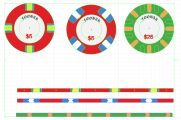deeoohhgee
High Hand
have sort of a couple technical questions related to AI & designing a chip ...
i've gotten some assistance with a template to start from, and i have noticed that the edge spotting is shaped in & the chip background is cut out to fit. i'll call this approach "pathing" since it's clearly all about manipulating paths to fit together, etc on the same layer. My question about this is: why do it it this way? My initial approach was to create a circle and layer the edge spot shapes onto the chip's background color. i'll call this approach "layering." Is pathing preferred because AI is vectorized? and if there are layers present the printing tool would try to overlay colors messing things up?
i've gotten some assistance with a template to start from, and i have noticed that the edge spotting is shaped in & the chip background is cut out to fit. i'll call this approach "pathing" since it's clearly all about manipulating paths to fit together, etc on the same layer. My question about this is: why do it it this way? My initial approach was to create a circle and layer the edge spot shapes onto the chip's background color. i'll call this approach "layering." Is pathing preferred because AI is vectorized? and if there are layers present the printing tool would try to overlay colors messing things up?

